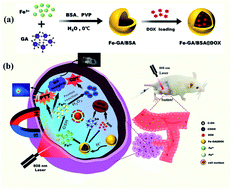pH-responsive hollow Fe–gallic acid coordination polymer for multimodal synergistic-therapy and MRI of cancer†
Abstract
Tumor-microenvironment (TME) responsive nanostructures are attractive for drug delivery in clinical cancer treatment. The coordination polymer Fe–gallic acid (Fe–GA) is one of the promising drug carriers due to its pH-response, good biocompatibility, and minimal side effects. However, the hollow nanostructures of Fe–GA have not been reported until now, which seriously limits the quantity of drug delivery. Herein, hollow Fe–GA nanospheres were prepared for the first time with bovine serum albumin (BSA) combination (denoted as Fe–GA/BSA) under mild reaction conditions. Then, the antitumor drug doxorubicin (DOX) was loaded in the hollow Fe–GA/BSA to obtain Fe–GA/BSA@DOX. A series of experiments in vitro and in vivo indicated that the Fe–GA/BSA@DOX could efficiently respond to TME and release DOX and Fe(III) ions. Furthermore, the Fe(III) could consume overexpressed glutathione (GSH) in cancer cells and generate Fe(II) to trigger the Fenton reaction, producing ·OH for chemodynamic treatment (CDT) of cancer. In addition, the Fe–GA/BSA@DOX could effectively convert near-infrared (NIR) light into heat by acting as a photothermal therapy (PTT) agent. Besides that, magnetic resonance imaging (MRI) data also showed that the Fe–GA/BSA had beneficial T1 and T2 imaging effects, demonstrating that the hollow Fe–GA/BSA has potential for multimodal synergistic cancer MRI diagnosis and therapies of drugs, CDT, and PTT.



 Please wait while we load your content...
Please wait while we load your content...